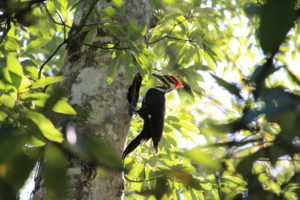
Identification:
- Long neck
- Chisel-like bill
- Mostly black
- White stripe on face and neck
- Red crest
- Males have a red stripe on the cheek
- 16-19 inches long
- 26 to 30 inch wing span
- weighs between 8 to 14 ounzes
- They show white on the wings when in flight
One of the largest forest birds on the continent
- Forest birds require standing dead trees and fallen wood to habitat an area
- These woodpeckers can live in a variety of forests from south to north to east and northwest
- Common in SWFL during all seasons
- Very loud and distinct sounding bird
- Pair stays together on its territory year-round and does not migrate
Pileated woodpeckers create distinct rectangular-shaped cavities in rotten wood to retrieve insects
- Eats berries off of limbs (including poison ivy berries)
- Scavenges through wood for ant hills (carpenter ants make up 60% of its diet)
- Eats fruits and nuts
- Eats insects including termites, larvae and beetles
Pileated Woodpeckers are important ecologically to many bird species since a variety of animals use old and excavated homes (since the woodpeckers do not re-use their homes). Animals that seek refuge in these areas are:
- Forest song birds
- Raccoons
- Other woodpecker species
- Tree nesting ducks
- Owls
- Wrens

Information provided by : https://www.allaboutbirds.org/guide/Pileated_Woodpecker/id and http://www.audubon.org/field-guide/bird/pileated-woodpecker
To hear the Pileated Woodpecker’s call visit: http://www.audubon.org/field-guide/bird/pileated-woodpecker
Shanna Weber
Photos courtesy of Ian Weber

